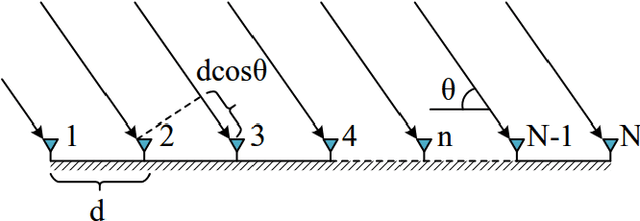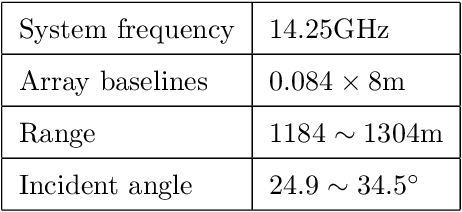Chibiao Ding
Conceptual Study and Performance Analysis of Tandem Dual-Antenna Spaceborne SAR Interferometry
Jun 17, 2023Abstract:Multi-baseline synthetic aperture radar interferometry (MB-InSAR), capable of mapping 3D surface model with high precision, is able to overcome the ill-posed problem in the single-baseline InSAR by use of the baseline diversity. Single pass MB acquisition with the advantages of high coherence and simple phase components has a more practical capability in 3D reconstruction than conventional repeat-pass MB acquisition. Using an asymptotic 3D phase unwrapping (PU), it is possible to get a reliable 3D reconstruction using very sparse acquisitions but the interferograms should follow the optimal baseline design. However, current spaceborne SAR system doesn't satisfy this principle, inducing more difficulties in practical application. In this article, a new concept of Tandem Dual-Antenna SAR Interferometry (TDA-InSAR) system for single-pass reliable 3D surface mapping using the asymptotic 3D PU is proposed. Its optimal MB acquisition is analyzed to achieve both good relative height precision and flexible baseline design. Two indicators, i.e., expected relative height precision and successful phase unwrapping rate, are selected to optimize the system parameters and evaluate the performance of various baseline configurations. Additionally, simulation-based demonstrations are conducted to evaluate the performance in typical scenarios and investigate the impact of various error sources. The results indicate that the proposed TDA-InSAR is able to get the specified MB acquisition for the asymptotic 3D PU, which offers a feasible solution for single-pass 3D SAR imaging.
A Novel Gradient Descent Least Squares (GDLS) Algorithm for SMV Gridless Line Spectrum Estimation with Efficiency
Mar 16, 2022



Abstract:This paper presents a novel efficient method for gridless line spectrum estimation problem with single snapshot, namely the gradient descent least squares (GDLS) method. Conventional single snapshot (a.k.a. SMV measurement) line spectrum estimation methods either rely on smoothing techniques that sacrifice the array aperture, or adopt the sparsity constraint and utilize compressed sensing (CS) method by defining prior grids and resulting in the off-grid problem. Recently emerged atomic norm minimization (ANM) methods achieved gridless SMV line spectrum estimation, but its computational complexity is extremely high; thus it is practically infeasible in real applications with large problem scales. Our proposed GDLS method reformulates the line spectrum estimations problem into a least squares (LS) estimation problem and solves the corresponding objective function via gradient descent algorithm in an iterative fashion with efficiency. The convergence guarantee, computational complexity, as well as performance analysis are discussed in this paper. Numerical simulations and real data experiments show that the proposed GDLS algorithm outperforms the state-of-the-art methods e.g., CS and ANM, in terms of estimation performances. It can completely avoid the off-grid problem, and its computational complexity is significantly lower than ANM. Our method shows great potential in various applications e.g. direction of arrival (DOA) estimation and tomographic synthetic aperture radar (TomoSAR) imaging.
SAR Image Classification Based on Spiking Neural Network through Spike-Time Dependent Plasticity and Gradient Descent
Jun 15, 2021



Abstract:At present, the Synthetic Aperture Radar (SAR) image classification method based on convolution neural network (CNN) has faced some problems such as poor noise resistance and generalization ability. Spiking neural network (SNN) is one of the core components of brain-like intelligence and has good application prospects. This article constructs a complete SAR image classifier based on unsupervised and supervised learning of SNN by using spike sequences with complex spatio-temporal information. We firstly expound the spiking neuron model, the receptive field of SNN, and the construction of spike sequence. Then we put forward an unsupervised learning algorithm based on STDP and a supervised learning algorithm based on gradient descent. The average classification accuracy of single layer and bilayer unsupervised learning SNN in three categories images on MSTAR dataset is 80.8\% and 85.1\%, respectively. Furthermore, the convergent output spike sequences of unsupervised learning can be used as teaching signals. Based on the TensorFlow framework, a single layer supervised learning SNN is built from the bottom, and the classification accuracy reaches 90.05\%. By comparing noise resistance and model parameters between SNNs and CNNs, the effectiveness and outstanding advantages of SNN are verified. Code to reproduce our experiments is available at \url{https://github.com/Jiankun-chen/Supervised-SNN-with-GD}.
Deep Discriminative Representation Learning with Attention Map for Scene Classification
Feb 21, 2019



Abstract:Learning powerful discriminative features for remote sensing image scene classification is a challenging computer vision problem. In the past, most classification approaches were based on handcrafted features. However, most recent approaches to remote sensing scene classification are based on Convolutional Neural Networks (CNNs). The de facto practice when learning these CNN models is only to use original RGB patches as input with training performed on large amounts of labeled data (ImageNet). In this paper, we show class activation map (CAM) encoded CNN models, codenamed DDRL-AM, trained using original RGB patches and attention map based class information provide complementary information to the standard RGB deep models. To the best of our knowledge, we are the first to investigate attention information encoded CNNs. Additionally, to enhance the discriminability, we further employ a recently developed object function called "center loss," which has proved to be very useful in face recognition. Finally, our framework provides attention guidance to the model in an end-to-end fashion. Extensive experiments on two benchmark datasets show that our approach matches or exceeds the performance of other methods.
 Add to Chrome
Add to Chrome Add to Firefox
Add to Firefox Add to Edge
Add to Edge